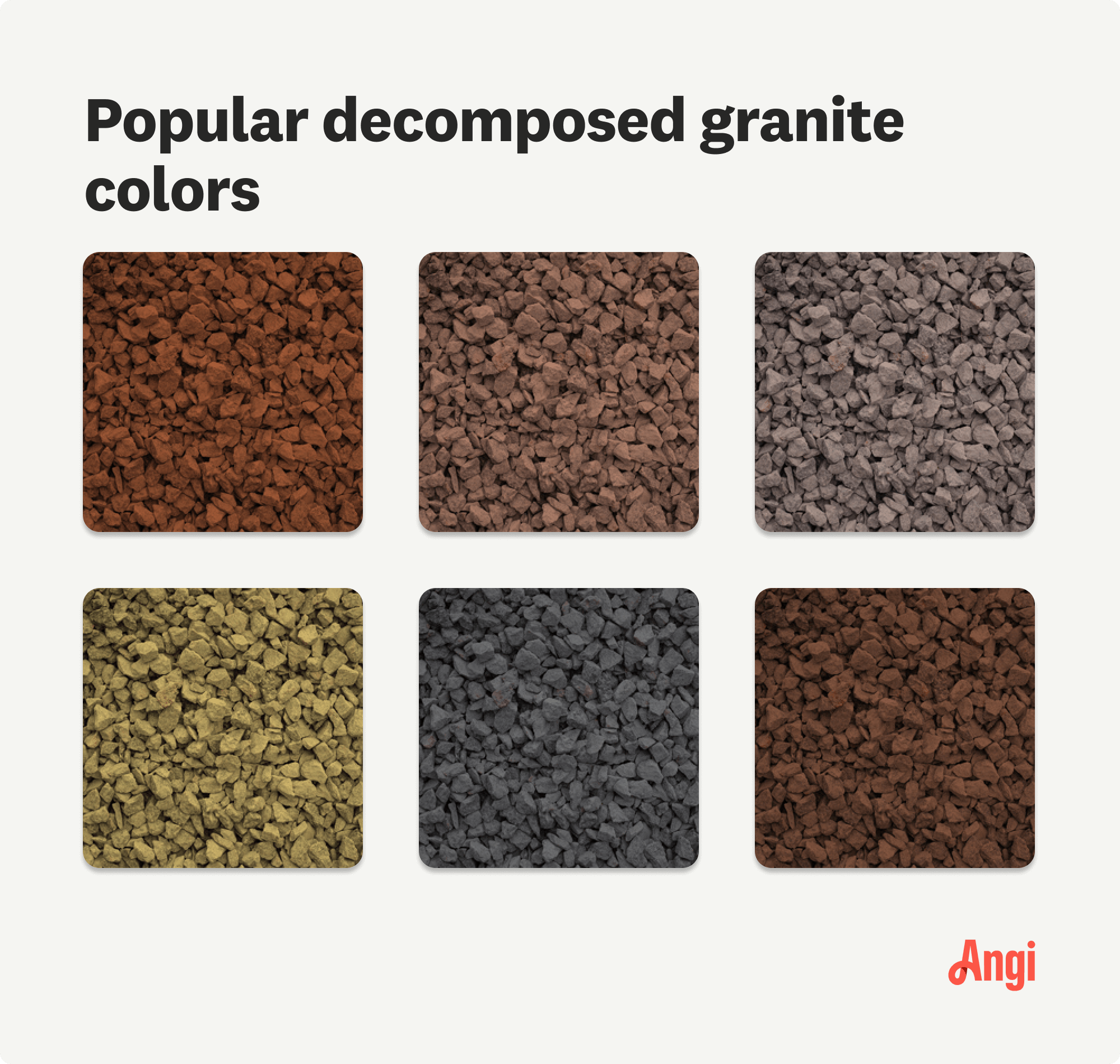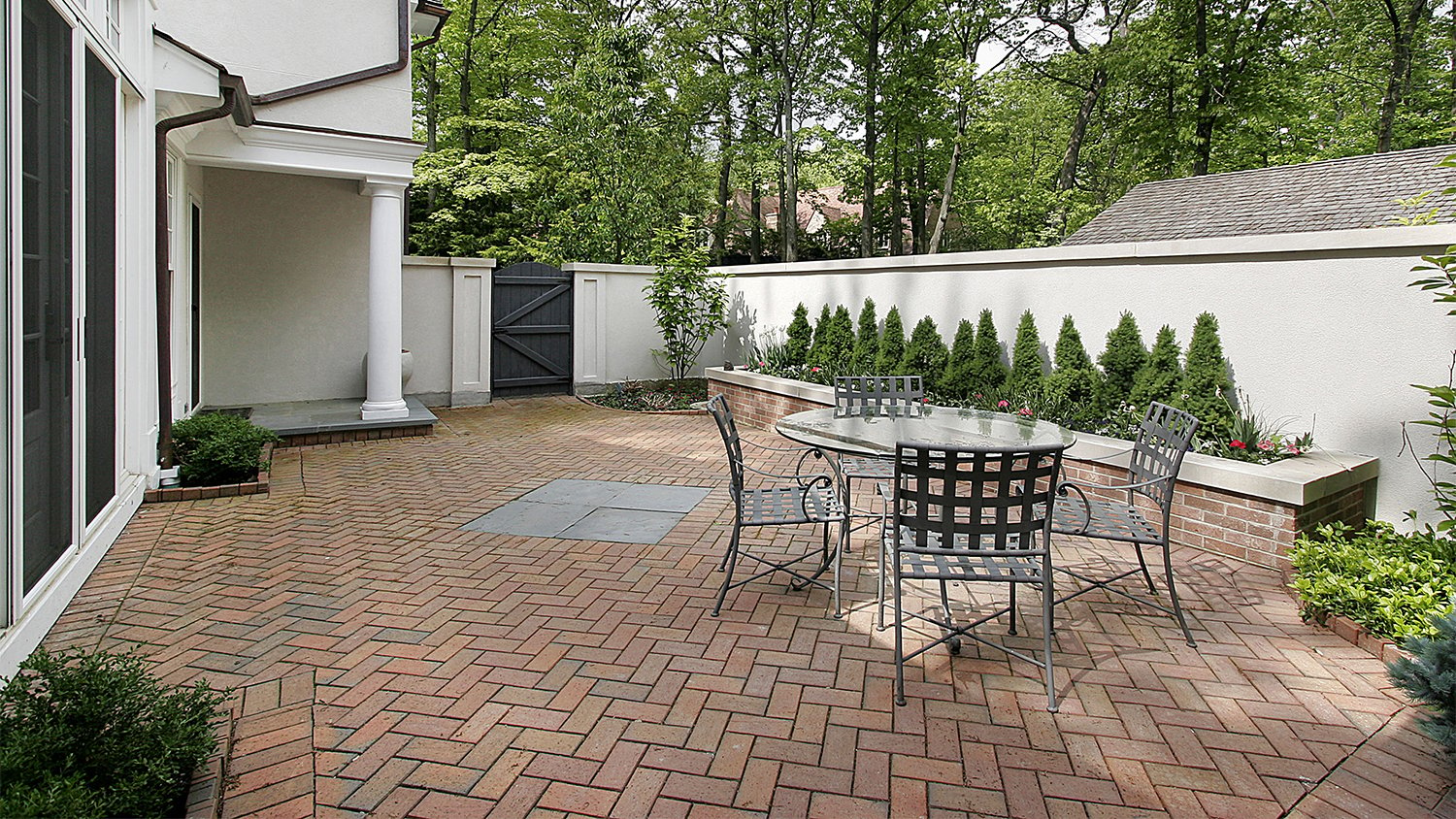How Much Does Decomposed Granite Cost? [2025 Data]
The national average cost for decomposed granite is $60 per ton, and most homeowners pay somewhere between $40 and $80 per ton, depending on the quality and quantity.


If your weather is mild, you can save quite a bit with natural decomposed granite.
While stabilizer or resin increases lifespan, it more than doubles and triples costs, respectively.
You can choose from many colors, but the most affordable are those available from your local stone options.
You could save upward of $800 if you DIY this project.
Decomposed granite costs around $60 per ton, on average, but you could pay anywhere from $20 to $300 per ton, depending on the size of the particles, the quality of the granite, and the add-ins for stabilization. Natural decomposed granite is the least expensive, while decomposed granite with stabilizers or resin will cost the most.
Decomposed Granite Cost Factors
Several factors affect how much you’ll pay for decomposed granite (often abbreviated as DG).
Size of Project
Decomposed granite costs an average of $40 to $255 per cubic yard, without installation or delivery costs. The amount you’ll pay for materials will depend on the size of your project.
| Project Size (sq. ft.) | Average Cost |
|---|---|
| 50 | $20–$115 |
| 100 | $40–$225 |
| 150 | $60–$340 |
| 200 | $80–$450 |
| 300 | $120–$675 |
| 400 | $160–$900 |
| 500 | $200–$1,125 |
Type
There are three types of decomposed granite: natural, DG treated with stabilizer, and DG mixed with resin. Natural DG is the least expensive but the least stable, so it’s not suitable for areas that see heavy rainfall, runoff, or strong winds that could cause the substrate to shift and erode. DG treated with stabilizer is a good alternative for greater longevity, and DG with resin is the most expensive but will stand up to even the most extreme weather.
| Type of Decomposed Granite | Average Cost (Per Ton) |
|---|---|
| Natural DG | $60 |
| DG treated with stabilizer | $185 |
| DG with resin | $225 |
Quality
Unstabilized decomposed granite does not contain binders or additives, making it more susceptible to storm run-off, wind, and impact erosion. Though you’ll pay about half as much for unstabilized decomposed granite as you would for stabilized DG, you’ll end up spending more on replacing sections of your landscape that become eroded over time.
This lower-quality DG is also more likely to get stuck on shoes as you walk on your pathway or patio, where it can accidentally come inside and scratch wood flooring. Choose a higher quality, stabilized DG for better stability and fewer maintenance costs in the long run.
Color
Decomposed granite comes in a variety of colors, which are available from various quarries. You’ll pay less for colors that come from nearby quarries, while harder-to-find shades, color blends, or colors that have to be transported longer distances will cost more.
Delivery
Because decomposed granite is heavy—one cubic yard weighs well over a ton—it’s unlikely you’ll be able to bring it home yourself. This means you’ll need to pay delivery costs to get the DG from the quarry or hardscape supply store to your home.
The average delivery cost for DG is $50 to $75 per load. This will depend on how much decomposed granite you buy and how far the delivery driver needs to travel.
Labor
On average, you can expect to pay $70 to $80 per hour for professional installation of your decomposed granite and overall landscaping costs. However, most local hardscape contractors won’t charge per hour. Instead, they determine how long it will take to complete your project and then quote you a flat rate.
For entire projects, you’re looking at somewhere between $350 and $800 for the labor. However, the total can extend well beyond these numbers in both directions, depending on your specific project.
Site Prep
When considering labor costs, you may also need to think about site preparation and the cost to clear land to make room for your decomposed granite. For example, if you’re installing a new driveway in an area that’s currently overgrown, you need to have that spot cleared and excavated. This could include removing trees and grading uneven terrain.
Assuming you’re building a driveway measuring 10 feet wide by 50 feet long, you could pay $1,500 to $2,000 to level and grade the area. If you need to remove trees, you might pay an extra $200 to $2,000 per tree.
You can create just about any landscape design on a hill, but if you have a severe slope a professional landscaper can help install new drainage. Pooling water can lead to damaged plants and yards.
Project Type

Seeing the cost of decomposed granite in terms of tons might not be all that helpful if you don’t know how much DG you need to complete your project. Generally speaking, one ton of decomposed granite will cost around $60 and will cover about 64 square feet at 3 inches deep. You might need to go deeper based on your project.
Here are a few examples of what you may pay for different projects. Keep in mind these prices only include materials or materials, delivery, and installation. Site preparation, such as removing trees or grading uneven terrain, is not included.
| Project (ft.) | Material Cost | Total + Installation |
|---|---|---|
| Driveway (50x10) | $800 | $1,750 (6 in. deep) |
| Patio (20x20) | $360 | $800 (3 in. deep) |
| Walkway (50x3) | $130 | $300 (3 in. deep) |
Location
Where you live can affect how much you’ll pay for decomposed granite. The farther you live from the quarry your DG comes from, the more expensive it’ll be. If your project is in a hard-to-access location that delivery trucks may have trouble getting to, expect to pay a premium for delivery.
DIY vs. Hiring a Pro to Install Decomposed Granite
Installing decomposed granite yourself will save you somewhere between $350 and $800, on average—although it depends on the specific project you have in mind and the size of the area you want to be covered with the material. While a DIY job is a great way to save some money, it’s not always a good idea. This is back-breaking work if you intend to do it solely by hand with shovels and wheelbarrows. It’s also a more expensive venture if you intend to rent heavy equipment to clear land, spread decomposed gravel, and compact the stone.
While you’ll save money on the labor, you’ll likely spend more time on the project than a pro would. Unless you have the experience and equipment to properly execute the job, calling a local gravel delivery service or a landscaper near you is usually your best bet.
Cost of Common Decomposed Granite Add-Ons
Elevating your outdoor space with decomposed granite is a great way to boost home value and make your yard more enjoyable. While you’re at it, consider these add-on options to boost your space even further.
Cost to mulch garden beds: $100–$800
Cost to install an outdoor pond: $1,200–$5,500
Cost to install outdoor lighting: $2,000–$6,000
Cost to install a paver patio: $2,400–$7,000
Cost to install a retaining wall: $3,200–$9,200
Cost to level or grade land: $1,000–$3,300
How to Save Money on Decomposed Granite Costs
Decomposed granite is a low-maintenance landscaping option, but it can still get quite expensive, especially for larger projects. Below are some ways you can save on costs.
1. Choose a Color That’s Abundant Locally

Decomposed granite is available in many different shades. Local quarries will often offer the best prices on locally sourced granite, as there are lower transportation costs. Choosing a shade that’s abundantly available locally will cost less than importing a color that may come from many miles away.
2. Buy All Your Decomposed Granite at the Same Time
As most quarries charge a flat rate for delivery based on your location, it makes the most financial sense to buy all the decomposed granite you’ll need for your various projects at the same time. When you do this, you’ll avoid having to pay multiple delivery fees for smaller loads. Make sure to take accurate measurements of your space before ordering to ensure you get the right amount for the coverage you need.
3. Prep Your Area Before Your Decomposed Granite Delivery
If you’re hiring a professional hardscaper for your decomposed granite, you can save a bit of money by taking on a bit of the labor yourself. Specifically, prepping your building site could be a job that requires no particular experience and no more equipment than what you already have in your shed. While grading and sloping land is a job best fit for the pros, you can consider doing other projects, like clearing bushes, cutting down small trees, and removing other obstacles.
How Angi Gets Its Cost Data
Home is the most important place on earth, which is why Angi has helped more than 150 million homeowners transform their houses into homes they adore. To help homeowners with their next project, Angi provides readers with the most accurate cost data and upholds strict editorial standards. We extensively research project costs to develop the pricing data you see, so you can make the best decisions for you and your home. We rely on reputable sources, including the U.S. Bureau of Labor Statistics, academic journals, market studies, and interviews with industry experts—all to ensure our prices reflect real-world projects.
Want to help us improve our cost data? Send us a recent project quote to costquotes@angi.com. Quotes and personal information will not be shared publicly.
Frequently Asked Questions
The depth of your decomposed granite depends on its intended use, but around 3 to 4 inches is the most common depth. Driveways that need to support a lot of weight should be at a depth of no less than 6 inches. Walkways that won’t see a lot of weight but lots of foot traffic should be built at a depth of 3 to 4 inches, and patios should also be between 3 and 4 inches deep.
To determine how much decomposed granite you need for your project, you need to first figure out the square footage of the surface. After that, you need to decide how deep the granite will go. Once you have these figures, you can use an online calculator to convert these measurements to cubic feet, or you can simply multiply the three numbers (in feet) to determine the number of cubic feet of decomposed granite you need. It’s a good idea to get about 5% to 10% more than you need just to be safe.
Because decomposed granite is a durable material, a crushed rock or gravel base is optional as long as the DG is properly installed and compacted. However, installing a base is a good idea because it will ensure proper drainage and stability and act as a weed suppressant (although you may still occasionally have to pull weeds). Installing an adequate base can also increase the durability of driveways and walkways. If you forego the paver base or gravel underneath, line the area with landscaping fabric to avoid weeds.
















